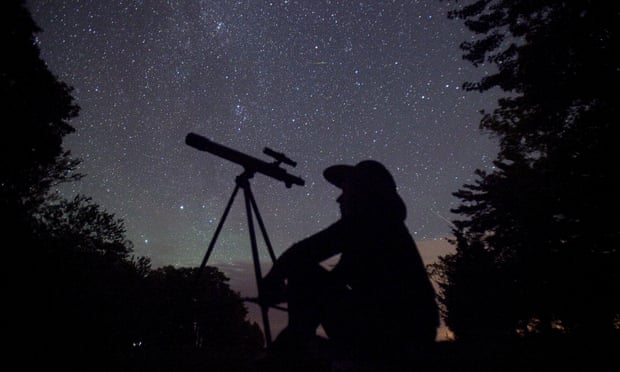‘Spooky’: the 1,300ft-wide asteroid to hurtle close to Earth on Halloween
TB145, a medium-sized chunk of rock and ice could that cause ‘continental-scale devastation’, will fly by at a distance slightly farther away than the moon
A large asteroid discovered only weeks ago will tear past the Earth on Halloween, Nasa has announced, estimating that it will come closer than any object of its size in the next 20 years.
The asteroid, nicknamed “the Great Pumpkin” and “Spooky” but technically known as TB145, is an estimated 1,300ft (400 meters) wide – 20 times bigger than the meteorite that screamed across the Russian sky and exploded over Chelyabinsk in 2013, shattering windows with shock waves and debris that injured more than a thousand people.
The Chelyabinsk object entered the atmosphere at about 12 miles (19km) per second. TB145 will fly past at around 22 miles per second (78,300mph), about 300,000 miles (483,000km) from Earth, slightly farther than the moon.
Scientists at Nasa’s Center for Near-Earth Object Studies discovered TB145 on 10 October and announced it to the public this week. The asteroid will make its closest approach on 31 October at about 1.05pm ET (5.05pm GMT). Nasa estimates that no similar object will make a comparable approach until 2027.
TB145 has an unusually oblong orbit, in an area searched less often than the flat-disc plane on which the solar system is arranged. TB145 slices through that plane at a 40-degree angle. Now it’s been spotted, the center’s Paul Chodas said its trajectory was “well understood”.
TB145 last passed by in 1975, when the Earth was at a different place in its orbit around the sun and Nasa’s surveys of the sky were far less comprehensive.
Lance Benner, of Nasa’s Jet Propulsion Laboratory, said in a statement: “Such a unique orbit, along with its high encounter velocity, raises the question of whether it may be some type of comet.”
Although TB145 will hurtle by “relatively close by celestial standards”, Chodas said in the statement “it is expected to be fairly faint, so night-sky Earth observers would need at least a small telescope to view it”.
Would-be skywatchers can turn to the internet for live telescope views provided by the Virtual Telescope Project.
The asteroid is far too small to exert any kind of gravitational pull on Earth’s plates or tides, Nasa said, with Benner adding that the agency would use radar imaging to examine the object in greater detail. The radar should reveal not only the surface of the object, but also whether it has a companion moon which could in turn provide clues to the object’s mass and density.
Had the asteroid been on a collision course with Earth, three-weeks’ notice “would have been too late to do anything about it”, Chodas told Popular Science.
“An asteroid of this size is really difficult to deflect with only 20 days’ warning,” he said.
Astronomers estimate that they have identified more than 90% of the largest “near-earth objects”, numbering more than 10,000 so far. TB145 ranks among the medium-sized objects, and was discovered by the Pan-STARRS telescope at the University of Hawaii.
A medium-sized chunk of rock and ice like TB145 could cause a catastrophe on Earth – “continental-scale devastation”, in Chodas’ words – if not quite a global disaster on the scale of the six-mile-wide asteroid that is blamed for the death of the dinosaurs. Medium-sized asteroids hit the earth once every 100,000 years, according to Nasa’s estimates.
Close calls are much more common. In January, an asteroid named BL86 slipped by at a similar distance as TB145.
Scientists are developing deflection (and destruction) plans for asteroids should they learn of an impending collision. Knocking the asteroid off course with spacecraft or nuclear weapons is one proposal, as is attempting to destroy the object.
Asteroid defense has several prominent advocates, including Britain’s royal astronomer. In the US, retired astronauts Ed Lu and Rusty Schweickart have created a foundation expressly to identify threats and plan for them.
For now, Nasa has simply assured the public that the skies are clear of danger, including from TB145.
“There are no known credible impact threats to date,” a statement said. “Only the ongoing and harmless in-fall of meteoroids, tiny asteroids that burn up in the atmosphere.”






No comments:
Post a Comment
Please leave a comment-- or suggestions, particularly of topics and places you'd like to see covered